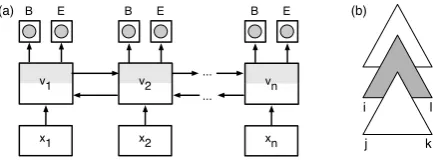Generalized chart constraints for efficient PCFG and TAG parsing
Full text
Figure




Related documents
The Disability Safe project implemented a mini project in 2014 whereby organisations were asked to allow a review of the past 2 years of workers compensation claims in
Three different forms are used in the trial: (1) baseline player data form collected at the start of the trial, (2) computer-based registration form collected every month, on which
We describe here the protocol for a twelve-month pro- spective, observational cohort study which aims, firstly, to describe the characteristics, management, and clinical
Rank-ordering of relative risks of diagnostic codes is a tool to quickly identify co-morbidities specific to a patient group of interest, in this case patients with rheu-
reported a subluxa- tion/reluxation rate of 13% (six of 45 operated knees) in an average follow-up examination period of 13.5 years, where 14 patients and 15 Roux-Elmslie-Trillat
Conclusion: Our findings show that the seroconversion of IgG-class anti-PF4/heparin antibodies differed with various anti-thrombotic prophylaxis therapeutics and was associated with
Qualitative and quantitative measurements of the shear wave velocities using virtual touch tissue imaging quantification (Acuson S3000, Siemens) of the erector spinae muscle (shear
The secondary outcome was the ability to rise from a chair and to climb stairs, range of motion (ROM), Knee Society Score (KSS), RAND-36 scores and radiological analysis of the